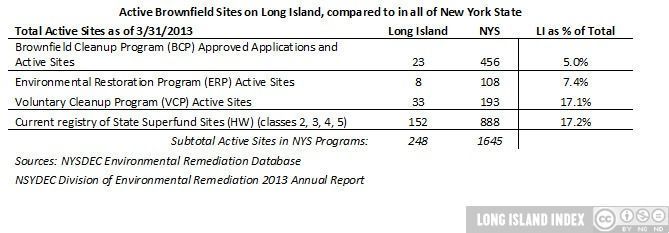Known sites of environmental contamination are located in 136 Long Island communities.
Why is this important?
New York State defines brownfields as properties where the presence or potential presence of a hazardous substance, pollutant, or contaminant may complicate plans for expansion, redevelopment or reuse. These sites include buildings that were former factories or dry cleaners, warehouses, vacant commercial lots, shuttered gas stations and auto shops. In addition to frequently being an eyesore in a community, they may pose environmental threats to surrounding areas and negatively impact ground water and the air supply. Revitalizing brownfields is critical both for environmental needs as well as to capture potential tax revenue, take development pressure off of open spaces, and to fully utilize a community’s potential assets.
How are we doing?
Long Island lags behind the rest of New York State when it comes to participation in and completion of state and federal brownfield cleanup programs. Statewide the New York State Department of Environmental Conservation (DEC) has identified 4,463 potential brownfield properties participating in state and federal programs such as the Brownfield Cleanup Program (BCP), the Environmental Restoration Program (ERP), the Voluntary Cleanup Program (VCP) the Resource Conservation and Recovery program (RCRA), or the state Superfund program and of those only 580 are on Long Island.

In addition, fewer new sites were added to the State’s Registry of Superfund sites in 2012-13 than in any year since 2006-7. As of March 2013 there were 483 Class 2 sites in New York, of which 103 are on Long Island. Class 2 sites represent significant threats to public health or the environment and require action, including an investigation and feasibility study to determine the nature and extent of contamination and to evaluate potential remedies.
This trend also continues with regard to the number of brownfield properties that have been completed (cleaned up or remediated) since the state programs began. Since 2003 when the state’s Superfund/Brownfield law went into effect, a total of 61 properties on Long Island have been assigned Classification C (“completed”), as compared to 735 statewide (see chart for details). This classification is used for sites where the Department has determined that remediation has been satisfactorily completed under a remedial program. State Superfund sites must have completed all active operation, maintenance, or monitoring requirements before they can be delisted and made class C.
Long Island also lags behind in national programs such as the federal Superfund program which is measured by the National Priorities List (NPL). Once sites have completed cleanup to federal standards they are “delisted” from the NPL. As of March 2013, 372 sites had been delisted (cleaned up) nationwide, with only 9 of those sites located on Long Island.
The road to cleaning up these sites varies by the type, extent and location of contamination. In addition to historically lower rates of participation in state programs, Long Island as a region faces three new obstacles with regard to brownfield redevelopment. The first new obstacle is that in October of 2012, Superstorm Sandy caused the release of petroleum and other chemicals that have contaminated properties along the south shore of Long Island. The state continues to investigate and clean up hundreds of these contaminated sites. The second is that the 2003 Superfund/Brownfield law which included authorization to bond new funds expired at the end of State Fiscal Year 2013. No extension has been passed to authorize bonding additional funding so DEC must use previously appropriated funds to maintain the program. Lastly, funding was not included for continuation of the New York State Brownfield Opportunity Area (BOA) program which incentivized local governments and community groups to work together to plan for a broader overall community-wide redevelopment plan for brownfields.
Sources:
Brownfields and Land Revitalization. US Environmental Protection Agency. October, 2014
New Partners for Community Revitalization, BOA Facts and Figures, August 2014
Office of Planning & Development, New York State Department of State. August, 2014
Search Superfund Site Information. US Environmental Protection Agency. August, 2014
